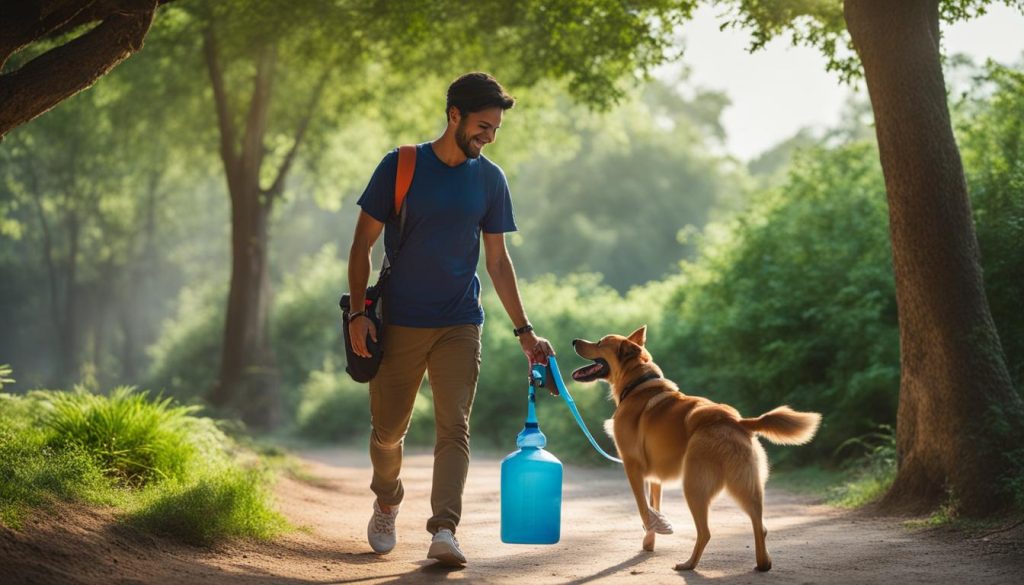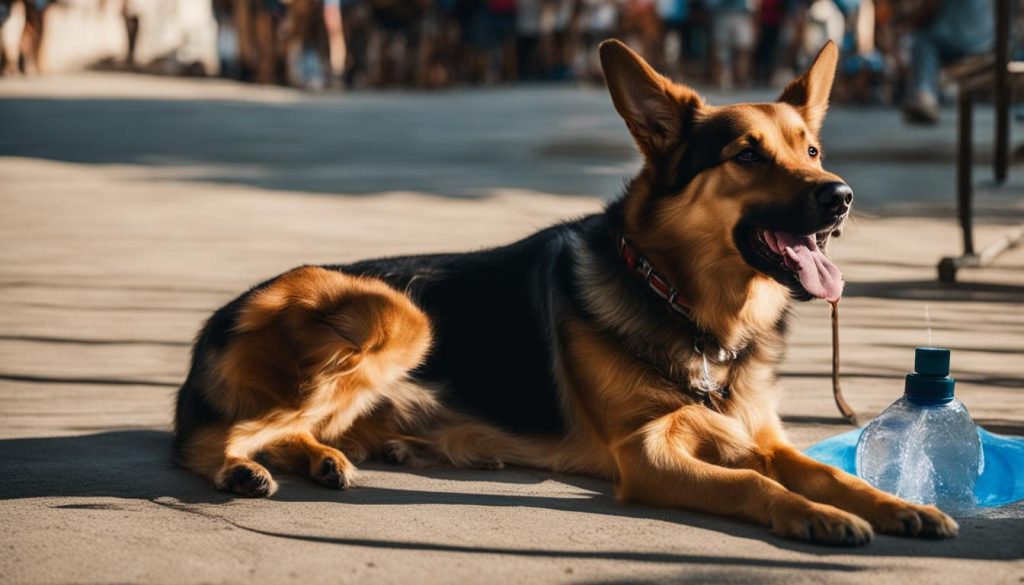Walking your dog is an essential part of their daily routine, providing exercise, mental stimulation, and an opportunity for bonding. However, when the weather gets scorching hot, it’s crucial to prioritize your dog’s safety and protect them from the potential dangers of extreme heat. Understanding when it’s too hot to walk your dog and taking preventive measures can help safeguard your furry friend’s health and well-being.
Key Takeaways:
- Pay attention to the temperature and pavement conditions before taking your dog for a walk in hot weather.
- Signs of heat exhaustion in dogs include seeking shade, excessive panting, nausea, and reddened skin.
- Heatstroke requires immediate veterinary attention and can be identified by symptoms such as confusion, excessive drooling, and loss of consciousness.
- Protect your dog’s paws from hot pavement by acclimating them to the weather, using moisturizing products, or using dog shoes or boots.
- Consider indoor alternatives for physical and mental stimulation on extremely hot days.
How Hot Is Too Hot for Dog Paws?

When it comes to walking your dog in hot weather, it’s important to protect their paws from the heat. So, how hot is too hot for your furry friend to walk on? The answer lies in the temperature of the ground. When the pavement temperature reaches 85 degrees Fahrenheit or higher, it can become uncomfortably hot for your dog’s paws.
According to the Journal of the American Medical Association, the asphalt temperature can reach a scorching 135 degrees when the air temperature is only 86 degrees. One way to determine if the ground is too hot for your dog is by using your own hand or foot. Place your hand or bare foot on the pavement for ten seconds. If it feels too hot for you, it’s definitely too hot for your dog’s sensitive paw pads.
To protect your dog’s paws, consider walking them during cooler times of the day, such as early morning or late evening when the pavement has had a chance to cool down. Alternatively, choose grassy or shaded areas for your walks. Another option is to invest in dog shoes or all-terrain boots that provide protection from hot surfaces. It may take some time for your dog to get used to wearing them, so be patient and introduce them gradually.
Heat-Related Health Issues for Dogs

Walking your dog in extreme heat can have detrimental effects on their health. The dangers of walking your dog in extreme heat include the risk of heatstroke, which can be life-threatening. Dogs are more susceptible to heat-related illnesses due to their limited ability to cool themselves down. It’s crucial to be aware of the signs of heat stress and heatstroke in dogs and take immediate action to prevent further complications.
Heat stress in dogs can occur when their body temperature rises above 104 degrees Fahrenheit. Some common signs of heat stress include excessive panting, seeking shade, limited movement, and excessive drooling. If not addressed promptly, heat stress can progress to heatstroke. Heatstroke is a severe condition that requires immediate veterinary attention. Symptoms of heatstroke may include confusion, loss of consciousness, seizures, and coma. It is essential to recognize these symptoms and take appropriate measures to cool your dog down and seek medical help.
To prevent heat-related health issues during walks, it is important to consider the temperature and adjust your walking routine accordingly. Avoid walking your dog during the hottest hours of the day and opt for cooler times, such as early morning or evening. Choosing shaded routes and grassy areas can also help protect your dog from the heat. Additionally, providing access to water throughout the walk and allowing your dog to rest when needed can help regulate their body temperature and prevent overheating.
Remember, dogs are more vulnerable to heat-related illnesses, especially those with underlying health conditions or certain breeds that are more prone to overheating. It is always better to err on the side of caution and prioritize your dog’s well-being by taking necessary precautions and seeking veterinary help if needed.
Table: Signs of Heat Stress and Heatstroke in Dogs
| Signs of Heat Stress | Signs of Heatstroke |
|---|---|
| Excessive panting | Confusion |
| Seeking shade | Loss of consciousness |
| Limited movement | Seizures |
| Excessive drooling | Coma |
Protecting Dog Paws in Hot Weather

Dog’s paw pads need special protection in hot weather to prevent injuries and discomfort. Pavement, sand, metal, and concrete can all become too hot for a dog’s paws, potentially causing burns and blisters. To safeguard your furry friend’s paws during walks in hot temperatures, there are several measures you can take.
Acclimate and Moisturize
One way to protect your dog’s paws is to acclimate them to the weather and stress by gradually increasing the amount of time spent walking on pavement during cooler weather. This helps toughen the paw pads and build resistance to hotter temperatures. Additionally, using moisturizing products specifically designed for paw pads can help prevent dryness and cracking, making them less susceptible to burns from hot pavement.
Consider Dog Shoes
Dog shoes or all-terrain boots are another option to protect your dog’s paws from hot surfaces. These shoes provide a barrier between the paw pads and the ground, shielding them from excessive heat. However, some dogs may need time to adjust to wearing shoes, so it’s recommended to introduce them gradually and provide positive reinforcement during the process.
Choose the Right Time and Location
When walking your dog in hot weather, it’s crucial to choose the best time of day to avoid extreme temperatures. Early mornings or evenings when the sun is not at its peak are usually cooler and safer for your dog. Additionally, opting for grassy or shady areas for walks can help minimize the risk of paw pad burns from hot pavement.
By taking these precautions and prioritizing your dog’s safety, you can ensure that their paws are protected during walks in hot weather, allowing them to enjoy outdoor activities without discomfort or injuries.
| Protecting Dog Paws in Hot Weather | Recommendations |
|---|---|
| Acclimate and Moisturize | Gradually increase pavement walking during cooler weather to toughen paw pads. Use moisturizing products to prevent dryness and cracking. |
| Consider Dog Shoes | Protect paw pads with dog shoes or all-terrain boots. Introduce shoes gradually and provide positive reinforcement during the adjustment period. |
| Choose the Right Time and Location | Walk your dog during cooler times of the day, such as early mornings or evenings. Opt for grassy or shady areas to minimize exposure to hot pavement. |
Basic Summer Safety for Pets

As the temperature rises, it’s essential to prioritize the safety and well-being of our furry friends. When walking your dog in hot weather, it’s crucial to take preventive measures to prevent heatstroke and other heat-related issues. By following some basic summer safety guidelines, you can ensure that your pet stays comfortable and protected during the scorching heat.
Providing Shade and Water
When your pet is outside, make sure they have access to shade where they can seek refuge from the hot sun. Additionally, always provide them with plenty of fresh, cool water to keep them hydrated. Adding ice cubes to their water bowl can further help lower their body temperature.
Avoiding High Temperature Exercise
Exercising your pet in extreme heat can be dangerous, especially for breeds that are more prone to heatstroke. Opt for walks during cooler hours, such as early morning or late evening, when the temperature is lower. If the pavement is too hot for your hand or foot, it’s too hot for your pet’s paws.
Recognizing Signs of Heat Stress
It’s vital to be aware of the signs of heat stress in pets. Heavy panting, excessive drooling, vomiting, and weakness are all indicators that your pet may be struggling with the heat. If you notice any of these symptoms, move your pet to a cooler area, offer them water, and contact your veterinarian for further guidance.
Never Leave Pets in Parked Cars
One of the most critical summer safety precautions is to never leave your pet unattended in a parked car, even for a short period. The temperature inside a car can rise rapidly, reaching dangerous levels that can result in organ damage or even death. Always prioritize your pet’s safety by keeping them with you or leaving them in a cool, well-ventilated environment.
By following these basic summer safety guidelines, you can ensure that your pet stays safe and comfortable during hot weather. Remember to prioritize their well-being, provide them with shade and water, and be vigilant for signs of heat stress. With these precautions, you can enjoy the summer months while keeping your furry friend happy and healthy.
Alternative Activities for Hot Days

If it’s too hot to walk your dog outside, there are alternative activities you can engage in to keep them active and entertained. Set up an indoor obstacle course with jumps, tunnels, and hoops to provide mental and physical stimulation for your dog. Food puzzles can also be used to keep your dog active and entertained during hot weather.
Playing ‘fetch’ on the stairs can be a fun and challenging activity if your dog is capable and the stairs provide a safe surface. You can also provide your dog with a cooling body wrap, vest, or mat to help keep them cool and comfortable indoors or in a shaded area. It’s important to find indoor alternatives to keep your dog active and prevent them from becoming bored or restless during hot days.
In summary, when the weather is too hot to walk your dog outside, try these alternative activities to keep them engaged and entertained: setting up an indoor obstacle course, using food puzzles, playing ‘fetch’ on the stairs, and providing cooling accessories. By keeping your dog active and mentally stimulated, even on hot days, you can ensure their well-being and prevent boredom or restlessness.
Dangers of Walking Your Dog in Extreme Heat

Walking your dog in extreme heat can pose serious risks to their health and well-being. It’s important to be aware of the dangers and take necessary precautions to ensure the safety of your furry friend. Excessive heat can lead to heat exhaustion and heatstroke, which can be life-threatening for dogs. Brachycephalic breeds, overweight or senior dogs, and certain breeds with thick coats are particularly susceptible to heat-related illnesses.
When the temperature rises, it’s crucial to pay attention to the signs of heat stress in dogs. These signs may include excessive panting, difficulty breathing, rapid heartbeat, weakness, and lethargy. If you notice any of these symptoms, it’s important to take immediate action to cool your dog down and seek veterinary assistance if necessary.
To protect your dog from the dangers of walking in extreme heat, it’s recommended to follow these safety guidelines:
- Avoid walking your dog during the hottest time of the day. Early morning or late evening walks are preferable when temperatures are cooler.
- Choose shaded routes or areas with grass instead of hot pavement.
- Bring water for both you and your dog to stay hydrated throughout the walk.
- Use a pet-friendly sunscreen to protect your dog’s exposed skin from sunburn.
- Consider using dog booties to protect their paws from hot surfaces.
By taking these precautions and being mindful of the risks, you can ensure the safety and well-being of your dog during hot weather.
How to Recognize and Treat Heat-Related Issues
Knowing how to recognize and treat heat-related issues in dogs is crucial for their well-being. By being aware of the signs and symptoms of heat exhaustion and heatstroke, you can take immediate action to protect your furry friend. Some common signs of heat exhaustion in dogs include excessive panting, drooling, lethargy, and vomiting. If you notice these symptoms, it’s important to move your dog to a cool, shaded area and offer them water to drink. Placing cool towels or ice packs on their head and chest can also help lower their body temperature.
In more severe cases, dogs may experience heatstroke, which is a life-threatening condition. Symptoms of heatstroke include collapse, seizures, difficulty breathing, and a rapid heart rate. If your dog is displaying these symptoms, it is crucial to seek immediate veterinary attention. While waiting for help, you can continue to cool your dog down by wetting their fur with cool water and using fans or air conditioning to create a cool environment.
Remember, prevention is key when it comes to heat-related issues. Avoid walking your dog during the hottest parts of the day and opt for early morning or evening walks instead. Provide plenty of shade and fresh water for your dog whenever they are outside. Additionally, never leave your dog alone in a parked car, as temperatures can rise rapidly and lead to heatstroke. By staying vigilant and taking proactive measures, you can help ensure the safety and well-being of your furry companion during hot weather.
Table: Signs of Heat Exhaustion and Heatstroke in Dogs
| Signs of Heat Exhaustion | Signs of Heatstroke |
|---|---|
| Excessive panting | Collapse |
| Lethargy | Seizures |
| Excessive drooling | Difficulty breathing |
| Vomiting | Rapid heart rate |
Please be aware that heat-related issues can vary depending on the individual dog and the severity of the heat. If you have any concerns about your dog’s health in hot weather, it’s always best to consult with a veterinarian for personalized advice and guidance.
Importance of Pet Safety During Power Outages
Power outages during summer storms can pose a danger to pets, especially in the case of extreme heat. It’s important to have a disaster plan in place to keep your pets safe from heatstroke and other temperature-related issues. Ensure your pets have access to a shaded and cool area during power outages. Provide them with ample fresh water and consider using cooling body wraps or mats to help regulate their body temperature. It’s crucial to monitor your pets closely during power outages and take immediate action if they show signs of distress or heat-related illness. Being prepared and attentive can help protect your pets during challenging situations.
Table: Pet Safety Tips During Power Outages
| Tip | Description |
|---|---|
| Provide Shade | Ensure your pets have access to a shaded area to avoid direct sunlight and high temperatures. |
| Keep Them Cool | Use cooling body wraps or mats to help regulate your pet’s body temperature during power outages. |
| Supply Fresh Water | Make sure your pets have access to ample fresh water to stay hydrated in the heat. |
| Monitor for Distress | Keep a close eye on your pets for signs of distress or heat-related illness and take immediate action if necessary. |
By implementing these pet safety tips during power outages, you can help protect your furry friends from the dangers of extreme heat. Taking proactive measures and being prepared for emergencies ensures the well-being of your pets even in challenging situations.
Wrapping Up
Walking your dog in hot weather requires careful consideration and attention to their safety and well-being. Understanding the dangers of extreme heat, protecting your dog’s paws from hot pavement, and recognizing the signs of heat-related issues are all essential for safeguarding your dog’s health.
If the temperature is too hot for your dog to walk outside, there are alternative activities and measures you can take to keep them active and comfortable. Indoor obstacle courses, food puzzles, and playing fetch on the stairs can provide mental and physical stimulation.
Taking precautions such as acclimating your dog’s paws to hot weather, using moisturizing products, and providing shade and water can help protect them during walks. By prioritizing your dog’s safety and following these guidelines, you can ensure that walking your dog in hot weather is done responsibly and with their health in mind.
FAQ
When is it too hot to walk your dog?
It is considered too hot to walk your dog when the pavement temperature is 85 degrees Fahrenheit or above.
How hot is too hot for dog paws?
The ground becomes too hot for dog paws when the pavement temperature is around 85 degrees Fahrenheit. If it feels too hot for your hand or foot, it’s too hot for your dog’s paws.
What are the signs of heat-related health issues in dogs?
Watch out for signs of heat stress and heatstroke in dogs, including seeking shade, limiting movement, uncontrolled panting, nausea, excess saliva, and skin reddening. Heatstroke may cause confusion, excessive drooling, dizziness, and loss of consciousness.
How can I protect my dog’s paws in hot weather?
To protect your dog’s paws, acclimate them to the weather by walking on pavement during cool weather. You can also use moisturizing products and consider using dog shoes or boots. Choosing grassy or shady areas can also help.
What are some basic summer safety tips for pets?
Never leave your pet in a parked car, provide ample shade and water, and limit exercise on hot days. Avoid the hottest time of the day and consider adding ice to your pet’s water during heatwaves.
What can I do with my dog on hot days instead of walking outside?
You can set up an indoor obstacle course, use food puzzles, or play ‘fetch’ on the stairs. Providing a cooling body wrap or mat can also help keep your dog cool and comfortable indoors or in a shaded area.
When should I be cautious about walking my dog in dangerous temperatures?
It’s important to be cautious when the temperature is over 77 degrees Fahrenheit. Consider your dog’s breed and health status, as well as weather conditions such as humidity and wind.
How can I recognize and treat heat-related issues in my dog?
Signs of heat exhaustion include heavy panting, rapid heartbeat, and lethargy. Heatstroke may cause dizziness, lack of coordination, vomiting, seizures, and unconsciousness. Move your dog to a shaded or air-conditioned area and seek immediate veterinary attention.
Why is pet safety important during power outages?
Power outages during extreme heat can pose a danger to pets. It’s important to have a plan in place to keep them cool and monitor them closely for signs of distress or heat-related illness.
What should I keep in mind when walking my dog in hot weather?
Consider the temperature, risks associated with hot weather, and your dog’s breed and health. If it’s too hot, find alternative activities to keep your dog active.






